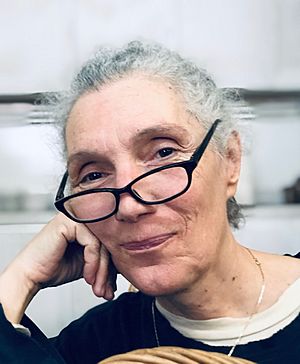Jana Sterbak facts for kids
Jana Sterbak (Jana Štěrbáková) is a multidisciplinary artist of Czech origin.
Life and career
Sterbak earned a Bachelor of Fine Arts at Concordia University, completing classes in film history with John Locke and Tom Waugh, as well as painting with Yves Gaucher Guido Molinari. In the 1980s, she studied art history at the University of Toronto and at New York University, ultimately abandoning her studies to dedicate herself to her artistic practice. In her artistic approach, performance is incorporated into her photography, film, and video installations.
In the 1990s, Sterbak moved to Paris to teach at the École nationale supérieure des beaux-arts (ENSBA). At age 36, a retrospective of her work was held at the National Gallery of Canada (1991) and subsequently shown at MIT in Boston and at the Museum of Contemporary Art San Diego (1992).
Her European career began in 1990 at Aperto, the international section of the Venice Biennale, where co-curator Bernard Blistène chose to present her work. Several solo shows followed: in 1992, at the Louisiana Museum of Modern Art (Denmark) and at the MoMA New York, where one of her iconic installations, Sisyphus, was presented (this work then joined MAC Marseille's collection,) and in 1993 at La Caixa Foundation in Barcelona. Velleitas, a solo exhibition curated by Corinne Diserens was presented in 1995 at the Musee d’art moderne of Saint-Étienne and at Fundació Antoni Tàpies in Barcelona, and at the Serpentine Gallery in London in 1996.
In the early 2000s, she produced two video installations. The first, From Here to there, represented Canada at the 2003 Venice Biennale; the second, Waiting for High Water, shot in Venice during the acqua alta phenomenon, was presented at the Prague Biennale in 2005. Waiting for High Water became her most exhibited video installation (catalogue text from Hubert Damisch.)
In 2012, Sterbak, a Canadian citizen since her twentieth birthday, received a Governor General's Award in the Visual and Media Arts, and in 2017, she won the Prix Paul-Émile-Borduas (Quebec).
"Her biography may not be directly reflected in her works, but it has provided a pool of experience for an examination of the question of how different societies are connected with one another. These are questions pertaining to human conflicts in contemporary life, to the tension between the private and public spheres, and between freedom and dependence. Jana Sterbak’s works are as poetic as they are political. They are conceptually precise, interweaving the immediacy of specific materials with references to motifs from mythology, literature, and philosophy. Her materials are often ephemeral and transformative, such as the ice that forms the slowly melting chairs of Dissolution-Auditorium, or the pieces of flesh sewn together to make a dress in her famous and much-discussed work and widely copied Vanitas: Flesh Dress for an Albino Anorexic." Both are powerful metaphors for social as well as physical processes that speak to us explicitly on a personal and sensory level.
Jana Sterbak’s artwork is notable in terms of its form and function, often at odds with each other. Several of her pieces take the familiar shape of furniture or clothing, but the use of incongruous materials give the work an alternate meaning. Her palette ranges from metal and wire, which may be considered permanent, unyielding, or restrictive, to the likes of bread, cake, chocolate, and/or meat, all of which are organic and evoke associations with food as well as the element of decomposition.
In a 1989 newspaper article, titled, “Art that is absolutely shocking,” author Brian Volke of The Leader-Post writes, “The works can be grouped into two general categories, furniture and dresses, both of which are usually considered part of the feminine domain. Both furniture- specifically beds and couches - and women symbolize similar things: rest, relaxation, care and pleasure. And both have been treated as commodities. Sterbak attacks these associations.” The article continues to cite specific installations of Sterbak’s work being shown at the Mackenzie Art Gallery, including “Attitudes” (1987), which features a king-sized bed with embroidered pillows that read, “Disease, Reputation,” and “Greed,” and also mentioned is an electrified wire garment titled, “I Want You To Feel the Way I Do… (The Dress).” Sterbak’s iconic piece, “Vanitas- Flesh Dress for an Albino Anorectic,” (1987) is noted for the way it, “conjures images of women as “pieces of meat” - commodities who starve themselves to fit into fashionable clothes. And the title reflects the perspective of an anorectic woman who, the meaning is clear, would rather wear a flesh dress than eat one,”
In 1992, Sterbak created “Catacombs,” in which various bones have been cast from solid chocolate, creating a sweet, edible, and incomplete human skeleton. In 1997, Jana Sterbak’s creations of a “bread bed” and “cake stool” play with symbols of livelihood. The comfort of an armchair takes on a morbid quality in “Chair Apollinaire,” (1996), made from raw meat. Artworks such as these might cause the viewer to question the value we place on food, and life, as such a fleeting and precious thing.
Awards
- 1991: Guggenheim Fellowship, John Simon Guggenheim Memorial Foundation, United States
- 1993: Prix Antoine Guichard, Foundation Casino, Musée de Saint-Étienne, France (now discontinued)
- 1993: Victor Martyn Lynch-Staunton Award from the Canada Council
- 1996: Prix Ozias Leduc, Fondation Émile-Nelligan, Montreal
- 2012: Governor General's Awards in Visual and Media Arts, Canada
- 2017: Prix Paul-Émile-Borduas, Québec
See also
 In Spanish: Jana Sterbak para niños
In Spanish: Jana Sterbak para niños


